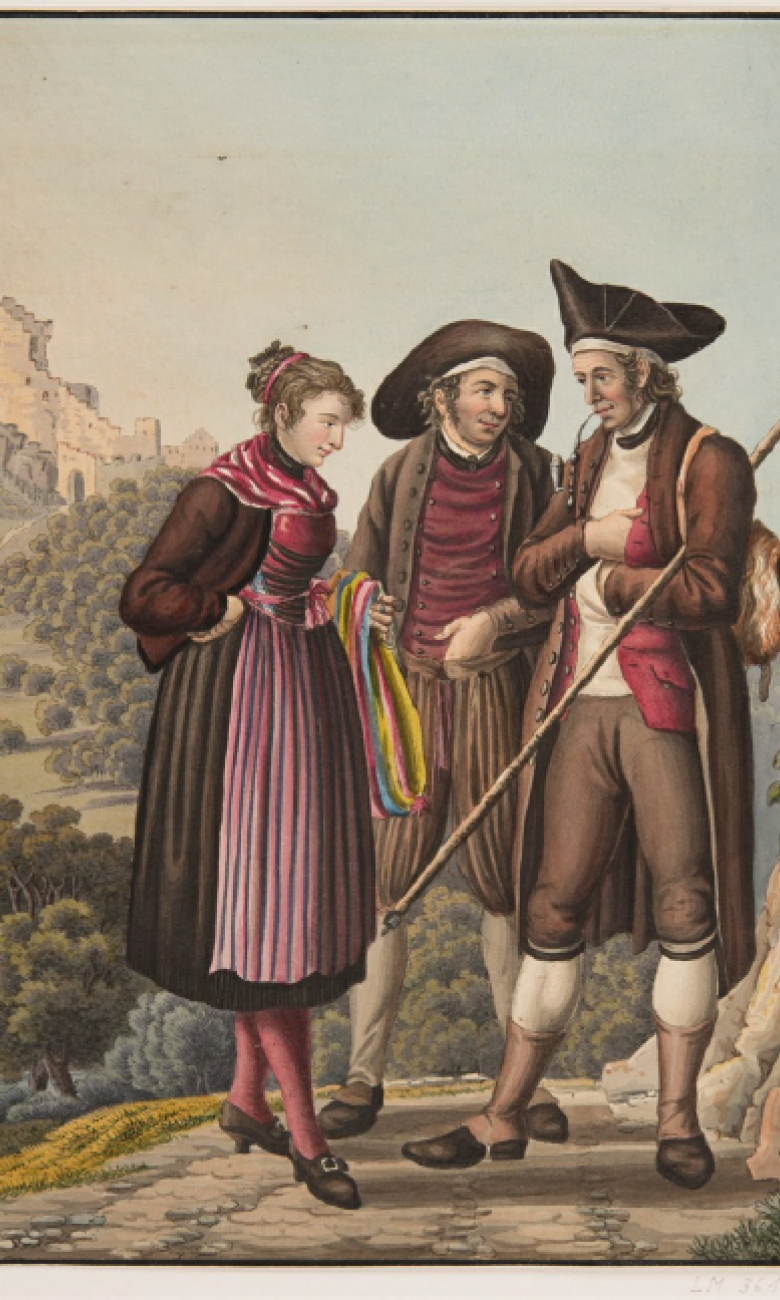Swiss traditional dress – a patchwork of Switzerland's history
Switzerland's national costumes are a symbol of centuries-old tradition, their richness reflecting the country's geographical and social diversity as well as its interactions with neighbouring countries.
For centuries Swiss people wore particular outfits associated with their occupation or background. Whether you were a farmer, a winegrower, a cook or an official, everyone could tell who you were and where you came from just by looking at your clothes. It was like wearing a sign that displayed your ID or speaking an accent revealing the place you were born. In Protestant parts, for example, puritan restraint meant clothes were more modest and simple; in the Catholic cantons, the pomp and circumstance of its religious ceremonies had an influence on people's taste for more lavish garments.
Traditional dress, girl from St Gallen (Fürstenland). Photographer Wehrli A.-G. Verlag, around 1904–24.
© Swiss National Museum, LM-171016. 37

Work and fashion
The traditional Swiss costumes worn today descend from the work clothes of yesteryear, the design of which was based on the specific needs of each profession – like company branding. Nowadays traditional clothing is but a harking back to historical dress, whether that's for daily work clothes or clothing for special occasions. In the countryside, people often made their own clothes from the linen, hemp or wool they produced themselves.

Influence from neighbouring countries
Although Swiss traditional dress is tied to the country's terrain and ancestral customs, it has always followed European trends closely. For example, when the sons of farmers were sent to war across the continent, they brought back new clothes with them. Another example is the tricorne some people in the canton of Neuchâtel continue to wear, a reminder that it used to be a Prussian principality until 1848, and that the aristocracy liked to live in the countryside. The women of Neuchâtel used to have a great fondness for a certain elegant summer straw hat, which was very fashionable in Versailles at the end of the 18th century when the ladies of the court dressed like shepherdesses.

Over to the Gotthard region on the other side of Switzerland, the traditional costumes of Glarus were naturally influenced by neighbouring Lombardy, and the womenfolk were quick to adopt a number of elegant fabrics including the Milan scarf. After that, a large blue linen blouse known as the bourguignonne quickly gained a foothold everywhere. Derived from the work clothes of French coachmen and merchants who came to trade in Switzerland, the baggy and robust bourguignonne even conquered the farmers of central Switzerland, who found it got less dirty than the white garments of the cowherds. In Valais, most traditional outfits include a ribboned hat dating back to the mid-18th century, probably inspired by a Parisian trend at the time. In 1890, it would take expert milliners two and a half days to make such a fancy headdress – which can hold up to 70 metres of ribbon – all for the price of two francs, which at the time amounted to the same as buying and keeping a cow, according to local farmers.

Outfits galore
The creation of more and more outfits was driven by women's fashions, which reached even the remotest valleys, and the desire to resemble those who were better off. Between 1788 and 1800, the painter Joseph Reinhardt from Lucerne produced 140 portraits of people in traditional dress. The huge choice of styles could be overwhelming, and worse still cheap imitations of traditional costumes came to be used for commercial or advertising purposes. Feeling dispossessed of their traditions, a lot of real country women stopped wearing traditional costumes, which had largely fallen out of fashion by the beginning of the 20th century.

Revival and tradition
As a symbol of long-standing tradition but also love for one's country, it was logical that traditional costumes were given a new breath of life in the midst of the First World War, at a time when the Swiss found themselves in a particularly precarious situation and were called upon to identify with patriotic values. The revival was led by the canton of Vaud, where the Vevey-Montreux region in particular (and its winegrowers' festival, the Fête des Vignerons, which offers a new take on Swiss tradition every year) has preserved a number of ancient customs almost intact. A first cantonal association was founded in 1916 in Sauvabelin, above Lausanne, under the leadership of Mary Widmer-Curtat, a doctor's wife. Ten years later, a national federation for traditional costumes (Schweizerische Trachtenvereinigung/Fédération nationale des costumes suisses) was founded in Lucerne, dedicated entirely to promoting folk costumes, dance, song and customs. Today, the federation has more than 15,000 members in 650 different groups – a whole host of enthusiasts to carry on the story of Switzerland's traditional dress.
This article by Jean-Blaise Besançon was first published in L'Illustré, January 2014




